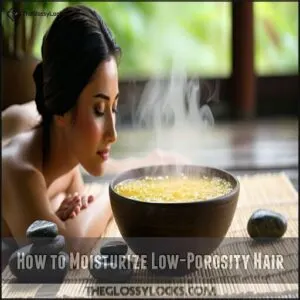This site is supported by our readers. We may earn a commission, at no cost to you, if you purchase through links.
 Hot oil treatments are great for low porosity hair because they help open up your hair’s tightly-packed cuticles, letting moisture and nutrients absorb more effectively.
Hot oil treatments are great for low porosity hair because they help open up your hair’s tightly-packed cuticles, letting moisture and nutrients absorb more effectively.
Low porosity hair tends to resist products, so using lightweight oils like grapeseed, olive, or even coconut oil as a warm treatment can make a big difference.
Think of it as giving your hair a spa day—it softens strands, reduces dryness, and boosts shine.
Just warm the oil (not too hot!), apply it from root to tip, and let it sit under a shower cap for 20-30 minutes.
Curious if it’s safe? Spoiler: it totally is, which makes it a great way to give your hair a warm treatment and have a big difference.
Table Of Contents
- Key Takeaways
- What is Low Porosity Hair?
- Why Hot Oil Treatments Are Good for Low-Porosity Hair
- How to Moisturize Low-Porosity Hair
- Oils That Penetrate Low-Porosity Hair
- How to Do a Hot Oil Treatment at Home
- Is Hot Oil Treatment Safe for Low Porosity Hair?
- Frequently Asked Questions (FAQs)
- Does hot oil work for low-porosity hair?
- What should I do if I have low porosity hair?
- Is olive oil good for low porosity hair?
- What is the best oil for low-porosity hair?
- Which oil is not good for low porosity hair?
- What products should I use for low porosity hair?
- How often should hot oil treatments be applied?
- What are the signs of effective oil absorption?
- Can hot oil treatments reduce product buildup?
- Do seasonal changes affect treatment effectiveness?
- Conclusion
Key Takeaways
- Hot oil treatments work well for low porosity hair by opening tightly packed cuticles, letting moisture and nutrients get in.
- Choose lightweight oils like jojoba, grapeseed, or argan to avoid buildup and ensure effective absorption.
- Warm the oil gently and let it sit under a shower cap for 20-30 minutes to maximize hydration and shine.
- Avoid thick oils like coconut and castor that can sit on top and cause buildup instead of penetrating.
What is Low Porosity Hair?
Ever wondered why your hair seems resistant to moisture?
Low porosity hair has tightly packed cuticles that make it difficult for water and products to penetrate.
This hair type is identified through the float test—place a clean strand in water and if it floats rather than sinks, you’ve got low porosity hair.
The cuticle structure creates a barrier that leads to product buildup on the surface instead of absorption.
Despite being challenging to moisturize initially, once hydrated, low porosity hair excels at moisture retention.
Understanding your hair porosity is the first step to developing an effective care routine, which involves recognizing the unique characteristics of low porosity hair.
Why Hot Oil Treatments Are Good for Low-Porosity Hair
Heat-rescue treatments release the full potential of low porosity hair.
Heat unlocks the hidden potential of low porosity hair, transforming resistant strands into a moisture-absorbing canvas.
When your hair cuticles are tightly packed, they create a moisture barrier that’s tough to penetrate.
Hot oil treatments work by gently opening these stubborn cuticles with warmth, allowing lightweight oils to slip inside rather than sitting on top.
This enhanced hydration process helps prevent buildup while delivering nutrients directly to your strands.
You’ll notice improved scalp health and better hair absorption overall, giving your strands a warm welcome mat for moisture instead of keeping the door locked.
Your hair’s thirst finally gets quenched!
How to Moisturize Low-Porosity Hair
Now that you understand why heat works wonders for low porosity hair, let’s tackle moisturizing those stubborn strands.
Heat unlocks the secret to hydrating low porosity hair, opening cuticles and ensuring moisture gets where it’s needed most.
Moisturizing low porosity hair isn’t impossible when you know what you’re doing. Your hair’s tight cuticles need special attention to accept moisture properly.
Here’s your five-step moisturizing game plan:
- Start with gentle cleansing to remove product buildup without stripping
- Apply lightweight humectants to attract moisture
- Use steam hydration to open hair cuticles
- Select non-heavy moisturizers that won’t sit on your strands
- Maintain a consistent routine, including regular hot oil treatments
Your low porosity hair can be well-hydrated with the right approach! Remember to use lightweight hair products for best results.
Oils That Penetrate Low-Porosity Hair
You’ll want to choose lightweight oils like argan, jojoba, and grapeseed that can actually penetrate your low-porosity strands instead of just sitting on top.
When warmed gently, these oils can slip between those tightly packed cuticles, delivering moisture where your stubborn hair needs it most.
Coconut Oil
Coconut oil can be a double-edged sword for low-porosity hair. Its medium-chain fatty acids let it penetrate the hair shaft—providing moisture from within—and its emollient properties smooth hair by filling gaps between strands.
However, due to its thick texture, coconut oil comedogenicity can lead to product buildup, especially on hair with tightly packed cuticles where moisture already struggles to enter.
If you’re considering using coconut oil in a hot oil treatment, applying heat is key. Warmed coconut oil becomes less viscous, allowing it to work deeply without sitting on top of your hair.
However, it’s not one-size-fits-all, so alternatives like grapeseed or jojoba oil might suit your hair better.
| Benefit | Challenge | Solution |
|---|---|---|
| Penetrates hair shaft | May cause buildup | Use light heat during application |
| Locks in moisture | Feels greasy without heat | Test sparingly on specific areas |
Some users seek products to address existing coconut buildup.
Olive Oil
Olive oil can be both a friend and foe for low porosity hair. While it offers hydration, its thick consistency may cause buildup.
To get the most from olive oil:
- Warm it gently—heating refines the structure, helping nutrients seep into the cuticle.
- Apply sparingly, focusing on ends to prevent greasy roots.
- Rinse thoroughly after 30 minutes.
Consider exploring olive oil products for specialized hair care. Prefer something lighter? Try jojoba or grapeseed oil for similar benefits with less heaviness. A regular hot oil treatment nourishes without overwhelming your locks!
How to Do a Hot Oil Treatment at Home
Treat your low porosity hair to a relaxing hot oil treatment at home.
Start by warming lightweight oils like argan or jojoba (not too hot!).
Follow these steps:
- Prep Your Oil: Heat your chosen blend (grapeseed, avocado) using a double boiler for even warming.
- Application Techniques: Apply to damp hair, massaging the scalp. Coat each strand.
- Seal with Heat: Use a thermal cap or towel for 15-20 minutes to boost oil penetration.
Finish with a gentle rinse and sulfate-free shampoo!
Is Hot Oil Treatment Safe for Low Porosity Hair?
After learning how to do a hot oil treatment, you might wonder if it’s safe for low porosity hair.
Hot oil treatments are generally safe, but consider your hair’s needs first.
Sensitive scalps or oil allergies? Test oils beforehand.
Heat damage is rare but avoid overheating oil.
Stick to lightweight options like jojoba to prevent product buildup.
And yes, rinse with cool water—closing the hair cuticle keeps moisture locked in.
Here’s a quick safety breakdown:
| Issue | Impact | Solution |
|---|---|---|
| Scalp Sensitivity | Irritation | Patch test oils first |
| Oil Allergy | Reaction | Choose hypoallergenic oils |
| Heat Damage | Brittle hair | Use moderate heat only |
| Product Buildup | Greasy strands | Lightweight oils work best |
| Hair Cuticle Opening | Moisture loss | Rinse with cool water |
Frequently Asked Questions (FAQs)
Does hot oil work for low-porosity hair?
Hot oil treatments work wonders for low-porosity hair.
Gentle heat opens cuticles, allowing oils to penetrate deeply.
It’s like giving your hair a warm hug, boosting hydration, reducing buildup, and leaving it softer and manageable.
What should I do if I have low porosity hair?
If you’ve got low porosity hair, focus on lightweight oils like jojoba or grapeseed.
Use heat to help products absorb, avoid heavy buildup-prone oils.
Rinse occasionally with a clarifying shampoo for balance.
Is olive oil good for low porosity hair?
Olive oil might surprise you.
While packed with nutrients, its thick texture often struggles to penetrate tightly locked cuticles of low porosity hair.
Stick with lighter oils like argan or jojoba for better absorption.
What is the best oil for low-porosity hair?
The best oils for low-porosity hair are lightweight options like jojoba, grapeseed, or argan oil.
They’re easy to absorb, won’t sit on your hair, and avoid greasy buildup while locking in hydration effectively, using lightweight options is key to maintaining healthy hair.
Which oil is not good for low porosity hair?
Thick oils like coconut and castor are your hair’s worst enemies when it’s low porosity.
They sit on top, causing buildup instead of absorbing.
Stick to lightweight oils for better hydration and shine.
What products should I use for low porosity hair?
Stick with lightweight oils like jojoba, argan, or grapeseed to hydrate without buildup.
Avoid heavy products like coconut oil or shea butter.
Look for moisturizing shampoos, leave-ins, and sulfate-free formulas that gently nourish your strands.
How often should hot oil treatments be applied?
Strike while the iron’s hot—apply hot oil treatments once a week for low porosity hair.
It keeps moisture at its peak, fights buildup, and makes your hair soft, shiny, and easy to manage.
What are the signs of effective oil absorption?
You’ll notice effective oil absorption when your hair feels softer, shinier, and less greasy.
The oil will soak in rather than sit on top, leaving strands hydrated and lightweight, not heavy or sticky.
Can hot oil treatments reduce product buildup?
Hot oil treatments can help reduce product buildup by breaking down residue stuck on your hair.
The heat opens your cuticles, allowing the oils to cleanse effectively while leaving your strands nourished and refreshed.
Do seasonal changes affect treatment effectiveness?
Seasonal shifts can impact treatment effectiveness, like how dry winter air or summer humidity affects hair’s needs.
Adjust oils and techniques to match the season, ensuring your hair stays nourished and hydrated year-round.
Conclusion
So, are hot oil treatments good for low porosity hair? Absolutely! They’re a simple, effective way to help your hair absorb moisture and nutrients more easily.
With lightweight oils like grapeseed or olive oil, and a few minutes of gentle heat, you can soften strands, boost shine, and reduce dryness.
Plus, they’re safe and easy to do at home, and it’s like a mini spa treatment that leaves your low porosity hair healthier and happier, making it a great way to give your hair a mini boost.







